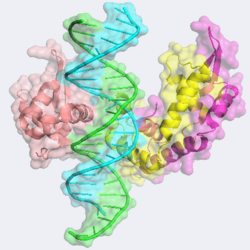FOXP2
From Proteopedia
(Difference between revisions)
| (3 intermediate revisions not shown.) | |||
| Line 1: | Line 1: | ||
| - | <StructureSection load='2a07' size='500' side='right' caption='Structure of FOXP2, [[2a07]]' scene='FOXP2/Opening/1'> | + | <StructureSection load='2a07' size='500' side='right' caption='Structure of FOXP2 complex with DNA, [[2a07]]' scene='FOXP2/Opening/1'> |
| - | [[Image:FOXP22.png|250px|left]] [[FOXP2]] is a family of forkhead transcription factors, which are part of a larger [[Forkhead box family]] of proteins. They play a crucial role in the development of the areas of the brain responsible for language and speech. In the 1990s, a family of individuals called the “KEs”, all of whom suffer from the same speech and language disorder, were discovered to be heterozygous for FOXP2 due to a mutation in one of their chromosomes. It has been suggested that the KEs lacked necessary concentrations of FOXP2 at critical times during their fetal brain development preventing the areas important for speech to develop.<ref>PMID: 11586336</ref> Nonfunctional FOXP2 alleles have been found to cause disruption of the striatum, a part of the basal ganglia responsible for speech. Further, spiny neurons within the striatum were found to have increased dendrite lengths and increased synaptic plasticity when FOXP2 mutant alleles were present, possibly causing the speech dysfunction. FOXP2 also has evolutionary implications. Two well-known amino acid substitutions, T303N and N325S appear to be the major substitutions in FOXP2 which separate the speech development patterns of chimpanzees and humans. Mouse models incorporating these mutations in FOXP2 demonstrated dramatically different ultrasonic vocalizations and decreased dopamine concentrations supporting FOXP2s involvement in the basal ganglia.<ref>PMID: 19490899</ref> The improper speech development associated with FOXP2 mutations are reminiscent of symptoms associated with [[autism]] and highlights a potential new target for [[Pharma drugs|therapeutic intervention]]. | + | [[Image:FOXP22.png|250px|left]] [[FOXP2]] is a family of forkhead transcription factors, which are part of a larger [[Forkhead box protein|Forkhead box family]] of proteins. They play a crucial role in the development of the areas of the brain responsible for language and speech. In the 1990s, a family of individuals called the “KEs”, all of whom suffer from the same speech and language disorder, were discovered to be heterozygous for FOXP2 due to a mutation in one of their chromosomes. It has been suggested that the KEs lacked necessary concentrations of FOXP2 at critical times during their fetal brain development preventing the areas important for speech to develop.<ref>PMID: 11586336</ref> Nonfunctional FOXP2 alleles have been found to cause disruption of the striatum, a part of the basal ganglia responsible for speech. Further, spiny neurons within the striatum were found to have increased dendrite lengths and increased synaptic plasticity when FOXP2 mutant alleles were present, possibly causing the speech dysfunction. FOXP2 also has evolutionary implications. Two well-known amino acid substitutions, T303N and N325S appear to be the major substitutions in FOXP2 which separate the speech development patterns of chimpanzees and humans. Mouse models incorporating these mutations in FOXP2 demonstrated dramatically different ultrasonic vocalizations and decreased dopamine concentrations supporting FOXP2s involvement in the basal ganglia.<ref>PMID: 19490899</ref> The improper speech development associated with FOXP2 mutations are reminiscent of symptoms associated with [[autism]] and highlights a potential new target for [[Pharma drugs|therapeutic intervention]]. |
====Structure of Monomeric FOXP2==== | ====Structure of Monomeric FOXP2==== | ||
| Line 9: | Line 9: | ||
</StructureSection> | </StructureSection> | ||
| - | + | ==Page Development== | |
This article was developed based on lectures given in Chemistry 543 by Prof. Clarence E. Schutt at Princeton University. | This article was developed based on lectures given in Chemistry 543 by Prof. Clarence E. Schutt at Princeton University. | ||
| Line 20: | Line 20: | ||
*[[Transcription & RNA Processing]] | *[[Transcription & RNA Processing]] | ||
*[[Regulation of Gene Expression]] | *[[Regulation of Gene Expression]] | ||
| + | *[[Foxp2 bound specifically to DNA]] | ||
Current revision
| |||||||||||
Page Development
This article was developed based on lectures given in Chemistry 543 by Prof. Clarence E. Schutt at Princeton University.
References
- ↑ Pinker S. Talk of genetics and vice versa. Nature. 2001 Oct 4;413(6855):465-6. PMID:11586336 doi:10.1038/35097173
- ↑ Enard W, Gehre S, Hammerschmidt K, Holter SM, Blass T, Somel M, Bruckner MK, Schreiweis C, Winter C, Sohr R, Becker L, Wiebe V, Nickel B, Giger T, Muller U, Groszer M, Adler T, Aguilar A, Bolle I, Calzada-Wack J, Dalke C, Ehrhardt N, Favor J, Fuchs H, Gailus-Durner V, Hans W, Holzlwimmer G, Javaheri A, Kalaydjiev S, Kallnik M, Kling E, Kunder S, Mossbrugger I, Naton B, Racz I, Rathkolb B, Rozman J, Schrewe A, Busch DH, Graw J, Ivandic B, Klingenspor M, Klopstock T, Ollert M, Quintanilla-Martinez L, Schulz H, Wolf E, Wurst W, Zimmer A, Fisher SE, Morgenstern R, Arendt T, de Angelis MH, Fischer J, Schwarz J, Paabo S. A humanized version of Foxp2 affects cortico-basal ganglia circuits in mice. Cell. 2009 May 29;137(5):961-71. PMID:19490899 doi:10.1016/j.cell.2009.03.041
- ↑ Yong PL, Russo P, Sullivan KE. Use of sirolimus in IPEX and IPEX-like children. J Clin Immunol. 2008 Sep;28(5):581-7. Epub 2008 May 15. PMID:18481161 doi:10.1007/s10875-008-9196-1
- ↑ 4.0 4.1 Stroud JC, Wu Y, Bates DL, Han A, Nowick K, Paabo S, Tong H, Chen L. Structure of the forkhead domain of FOXP2 bound to DNA. Structure. 2006 Jan;14(1):159-66. PMID:16407075 doi:10.1016/j.str.2005.10.005
See Also
- Forkhead box family
- Forkhead box protein M1
- Transcription & RNA Processing
- Regulation of Gene Expression
- Foxp2 bound specifically to DNA
Proteopedia Page Contributors and Editors (what is this?)
David Canner, Michal Harel, Wayne Decatur, Alexander Berchansky

